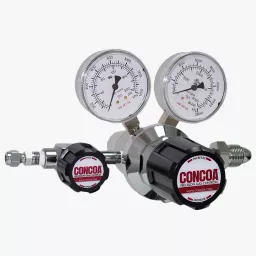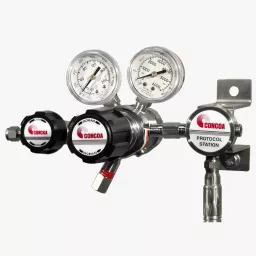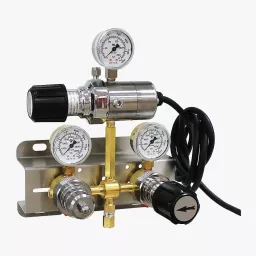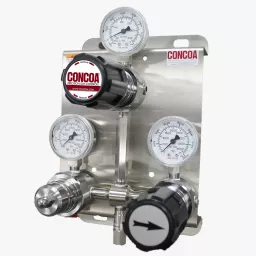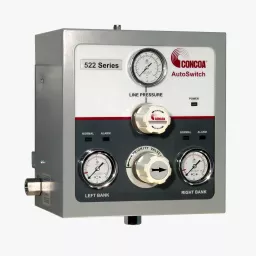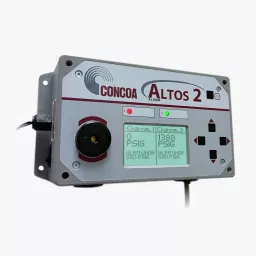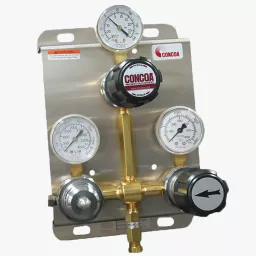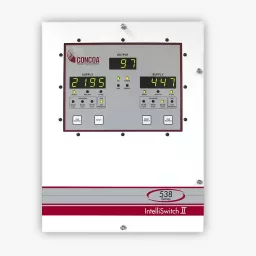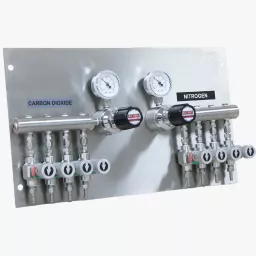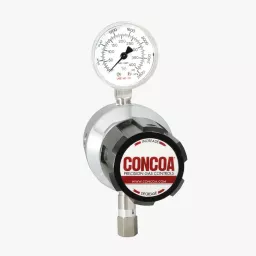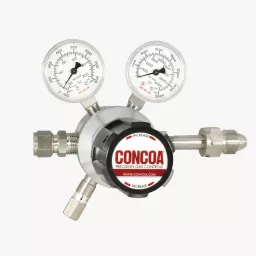Cells are grown and maintained at an appropriate temperature and a gas mixture of oxygen, carbon dioxide, and nitrogen in a cell incubator. The unique properties of these gases, coupled with specific system requirements, can be challenging for those designing, installing, and operating incubation systems. Therefore, system efficacy centers on properly designing, sizing, and supplying a system from gas source to point-of-use.
The carbon dioxide and nitrogen gas supply should be sufficient for one week’s operation in cell culture incubation applications. This requires determining the daily flow requirement for each incubator supplied from the same source, recognizing that flow is non-continuous. Instead, total flow is dependent on the duty cycle of the equipment, which is affected by how often the chamber is opened to remove or replace samples. The typical average flow for both carbon dioxide and nitrogen in a single-chamber incubator is between 6 and 12 liters of gas per minute at an inlet pressure of 6 to 15 PSIG. The maximum inlet pressure for most incubators is limited to as low as 15 to no more than 50 PSIG. This means maintaining accurate and stable point-of-use pressure is critical.
The time the gas flows may be somewhat short as it only occurs after an incubator door is opened to add or remove samples, which drops the chamber's carbon dioxide level and raises the oxygen level. Once the door is closed, low pressure solenoid control valves are opened to inject the gases into the chamber to reestablish the desired atmospheric concentration of carbon dioxide, oxygen, and nitrogen. The typical carbon dioxide level inside an incubator is maintained at 5% balance air, but for some applications with mammalian cell lines or in-vitro fertilization, the oxygen concentration is reduced by also injecting nitrogen to between 5 and 8% oxygen instead of the nominal 20.9% oxygen in air concentration. Some gas is also consumed over time by the biological process, but that amount is fairly small, so the hourly demand over time may be minimal under normal operations.
Normal incubation operations may use a 10% duty cycle, while active operations may use 30%. Totaling weekly demand per incubator will determine the correct net gas supply needed for one week. The initial source for gases like nitrogen and carbon dioxide is high pressure cylinders. However, there are alternative supply sources that become more attractive for active installations requiring a higher weekly volume of gas. By calculating the total weekly demand for carbon dioxide and nitrogen, the best gas delivery system and form of delivery can be determined for each installation of cell culture incubators.
For smaller operations using high-pressure cylinders, the 212 Series regulator maintains constant outlet pressure to the incubator, while two-stage regulation allows for higher flow without freezing. A 529 Series protocol station provides an easy way to wall-mount or incorporate multiple cylinders of the same gas. For continuous supply or higher duty cycles, a special 526 CD Series pressure differential switchover with an integral heated line regulator or a 527 Series switchover may be used. Another high pressure option is a 522 Series enclosed switchover. CONCOA switchover systems are designed to interface with CONCOA remote alarms to provide audible and visual warnings of cylinder depletion for continuous system operation. For active operations with a continuous duty cycle, a 526 Series LC pressure differential switchover supports cryogenic liquid cylinder primary sources with high pressure reserves. However, for these operations CONCOA strongly recommends a 538 Series IntelliSwitch II for fully automatic switchover delivered safely and efficiently from primary and secondary liquid carbon dioxide and nitrogen sources, which can greatly reduce or eliminate venting and residual gas return. Finally, the CONCOA 55 Series point-of-use panel, with 400 Series regulators, such as the 484 or 486 Series, provides final line pressure control and individual line isolation of those gases used in incubator systems. As with any bulk or sizable liquid cylinder installation, a 580 Series oxygen deficiency monitor should be installed in storage and use areas, and any pipeline-relief valves should be piped to an appropriate exterior vent line as per building safety code requirements. The relief valves on cryogenic liquid cylinders cannot be piped away and are exempt from this requirement. Adequately sizing a gas delivery system for cell culture incubators as closely as possible ensures that the required daily demand is satisfied with optimal efficiency. Additionally, with the right equipment, the amount of CO2 released by the container’s relief valves is minimized or eliminated as much as possible.The expansion of biopharmaceutical facilities has radically increased the demand for lab gases such as nitrogen and carbon dioxide for the growth of tissue culture cells in incubation applications. The oxygen concentration is controlled by nitrogen and measured indirectly by measuring oxygen and carbon dioxide. Control of temperature, humidity, pH, oxygen, and carbon dioxide in a sterile environment is critical for maximizing biological cell growth.
Properly growing the irreplaceable biological samples typically found in incubators requires an uninterrupted, continuously available supply of gas. The key here is "continuously available supply," because the gas for cell culture incubators, though required to be uninterrupted, is not a continuous 24/7 flow. In addition to determining what type of gas delivery system is required for a facility's incubation application, it is important to evaluate the amount of gas required for daily operation and the options for supplying that demand. From this, the best form of supply and gas delivery system can be determined.
For withdrawal from high-pressure cylinders, CONCOA's 212 Series regulator maintains constant outlet pressure to the incubator, while two stage regulation allows for higher flow without freezing. Incorporating a protocol station provides an easy way to wall mount or incorporate multiple cylinders of the same gas. For higher duty cycles or continuous supply, the 527 Series Switchover with optional remote alarm at the gas source provides notification that a switchover to reserve has occurred, or the 526 CD Series pressure differential switchover, with integral heaters, may be used. For fully automatic switchover from primary and secondary liquid carbon dioxide and nitrogen sources, CONCOA strongly recommends the 538 Series IntelliSwitch™ II, which can greatly reduce or eliminate venting and residual gas return. CONCOA's 55 Series Point-of-Use Panels with 400 Series regulators provide final line pressure control and individual isolation to incubator systems. Successfully growing irreplaceable biological samples requires an uninterrupted, continuously available supply of high-pressure gas or cryogenic liquid at specific process conditions.

